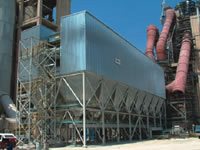 Factory undergoes upgrade
Factory undergoes upgrade
When completed PPC’s De Hoek upgrade will deliver reduced dust and noise emissions while increasing efficiencies and quality in the production process
PPC is the leading supplier of cement in southern Africa through eight cement manufacturing facilities and three milling depots in South Africa, Botswana and Zimbabwe that can produce around eight million tons of cement products each year. PPC also produces aggregates, metallurgical-grade lime, burnt dolomite and limestone.
As part of its cement modernisation projects The De Hoek factory situated in the Western Cape is undergoing a R280 million upgrade of kiln 6.
The project is well underway and at the timeof going to press the engineering design and procurement phases were complete.The construction phase has commenced.
The civil works is nearing completion and the mechanical, structural steel and electrical contractors are currently on the construction site.
On completion the factory will be able to optimise its clinker cooling process through the installation of a new grate cooler for kiln 6 to replace the old satellite coolers. Clinker is the key ingredient for cement and is produced by burning a mixture of primarily limestone to temperatures of 1400 degrees Celsius in a coal fired rotary kiln.
This clinker needs to be cooled on exiting the kiln. For optimal operation of the grate cooler, the old direct coal firing system will be changed to an indirect system together with the installation of a new kiln burner.At least three quarters of the old kiln shell will be replaced with new kiln shell as well as two new riding rings.
A new kiln inlet seal will also be installed. The current electrostatic precipitator (ESP), which filters air emissions, serving the raw mill and kiln will also be replaced with the installation of a new bag filter.
Grate Cooler & ESP
Grate cooler technology for clinker cooling is the current international best practice as this increases kiln operating stability and improves clinker quality.
Therefore a decision was taken to install a new grate cooler and ESP. DHK6 is presently producing approximately 1 600 tpd of clinker; however, the old satellite cooler is a production bottleneck, resulting in major wear of the satellite cooler internals and increased maintenance intervals and cost as well as heat loss due to surface radiation through the cooler tubes.
Installation of a new 2 000 tpd grate cooler will increase clinker output by approximately 50 tpd due to improved kiln stability, improved kiln thermal efficiency and increased utilisation by reducing cooler maintenance.
The improved cooling technology cools clinker rapidly to below the current clinker temperature thus improving the grindability of the clinker in the finish milling stage and also improves downstream clinker handling and storage.
Indirect Firing System
The Indirect Kiln Firing System upgrade includes the conversion of the existing coal milling plant and the installation of a modern multi-channel kiln burner.
This will result in improved kiln thermal efficiency by reducing the amount of lower temperature primary air entering the kiln and replacing it with higher temperature secondary air from the grate cooler, thus improving combustion.
The kiln exhaust gas is used for coal drying instead of process gas from the kiln, resulting in better kiln energy consumption. Moisture from the milled coal is vented with the coal mill exhaust gas and does not enter the kiln primary air stream as it currently does.
The installation of a dynamic separator to replace the static unit increases the coal milling capacity which enables the use of lower grade coal.
The multi-channel burner flame can be adjusted over a wider range during operation resulting in extended kiln refractory life. The multi-channel burner also enables selected secondary fuels or waste materials to be used, reducing the amount of coal used for kiln firing.
The optimum benefit can only be derived from the combination of the Grate Cooler and the Indirect Firing System.
Kiln Shell & Riding Rings
The kiln 6 kiln shell sections to be replaced are from a few meters upstream from riding 2 to the kiln outlet. Riding ring 2 (RR2) and riding ring 3 (RR3) will also be replaced and a new kiln inlet seal will be installed. The kiln girth gear will be turned during this period.
Future legislation will limit dust emissions to less than 50 mg/Nm3 and the existing kiln ESP dust collection efficiency will not be able to achieve this. The new Raw Mill/Kiln Bag Filter installation will achieve these dust emission limits. The project to date has maintained an excellent safety record with no Lost Time Injury (LTI)
